Innovation and Commercialization Report: Strategies for SMEs
VerifiedAdded on 2019/11/29
|13
|5000
|186
Report
AI Summary
This report examines the crucial role of innovation and commercialization for Small and Medium Enterprises (SMEs). It begins by highlighting the importance of innovation, leadership, culture, and teamwork, using Tesco Mobile as a case study. The report then delves into the 4Ps of innovation (product, process, position, and paradigm) and explores frugal innovation as a key strategy for SMEs, especially in emerging markets. Furthermore, it discusses the commercial funnel and New Product Development (NPD) processes. The report also analyzes an innovation business case and concludes with a discussion on knowledge and intellectual property management. The analysis draws on examples from companies like Apple to illustrate key concepts and strategies for fostering innovation and achieving commercial success.

Running head: INNOVATION AND COMMERCIALIZATION
Innovation and Commercialization
Name of the student:
Name of the university:
Author note
Innovation and Commercialization
Name of the student:
Name of the university:
Author note
Paraphrase This Document
Need a fresh take? Get an instant paraphrase of this document with our AI Paraphraser
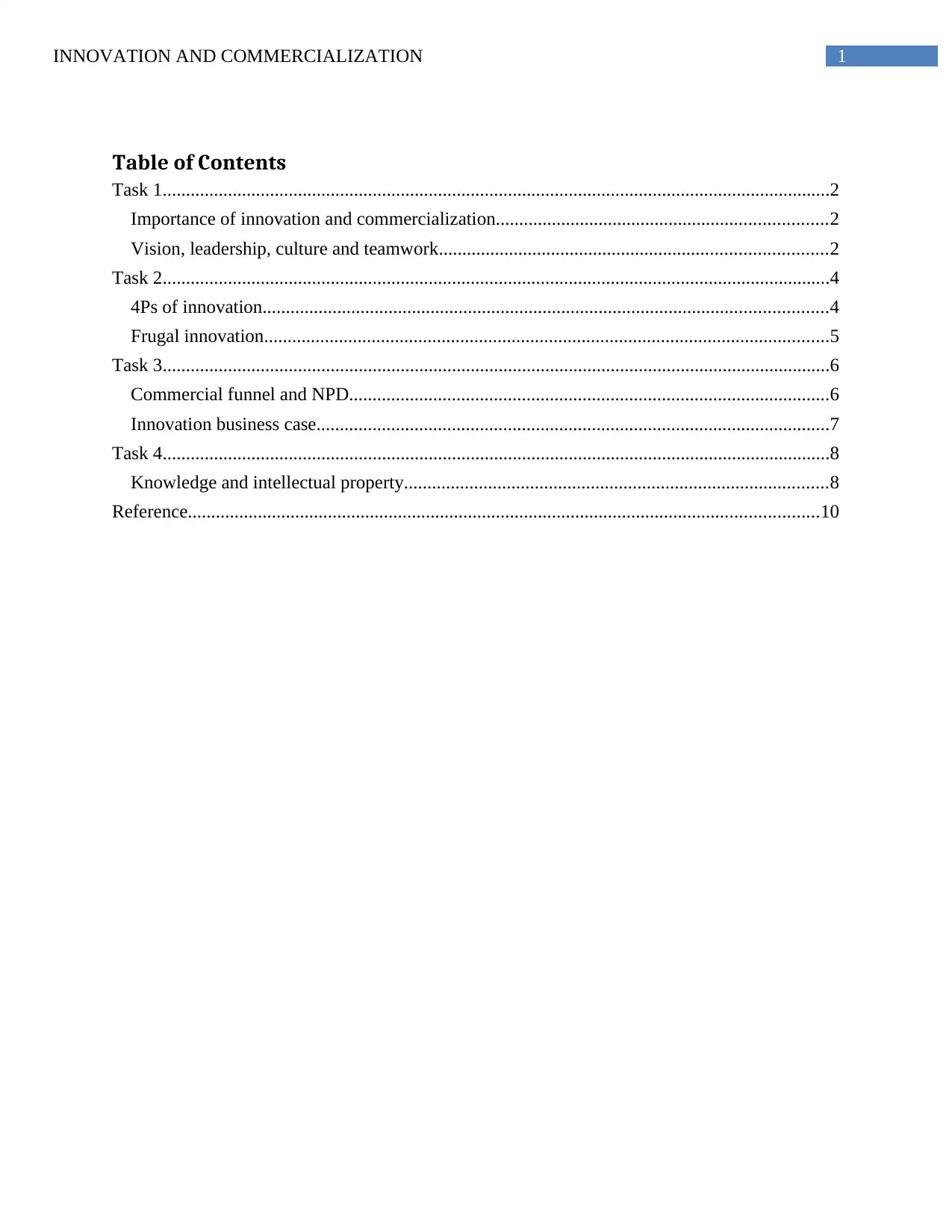
1INNOVATION AND COMMERCIALIZATION
Table of Contents
Task 1...............................................................................................................................................2
Importance of innovation and commercialization.......................................................................2
Vision, leadership, culture and teamwork...................................................................................2
Task 2...............................................................................................................................................4
4Ps of innovation.........................................................................................................................4
Frugal innovation.........................................................................................................................5
Task 3...............................................................................................................................................6
Commercial funnel and NPD.......................................................................................................6
Innovation business case..............................................................................................................7
Task 4...............................................................................................................................................8
Knowledge and intellectual property...........................................................................................8
Reference.......................................................................................................................................10
Table of Contents
Task 1...............................................................................................................................................2
Importance of innovation and commercialization.......................................................................2
Vision, leadership, culture and teamwork...................................................................................2
Task 2...............................................................................................................................................4
4Ps of innovation.........................................................................................................................4
Frugal innovation.........................................................................................................................5
Task 3...............................................................................................................................................6
Commercial funnel and NPD.......................................................................................................6
Innovation business case..............................................................................................................7
Task 4...............................................................................................................................................8
Knowledge and intellectual property...........................................................................................8
Reference.......................................................................................................................................10
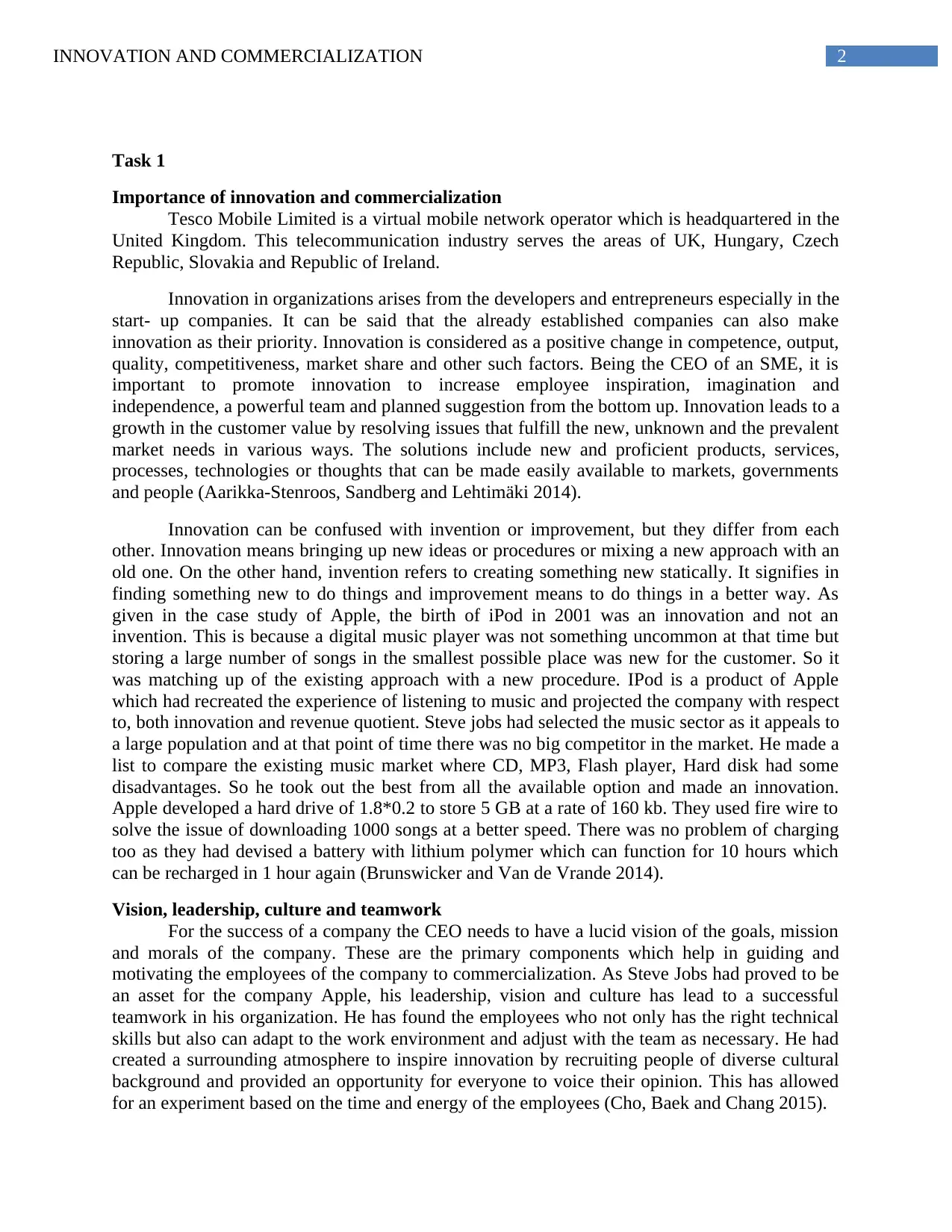
2INNOVATION AND COMMERCIALIZATION
Task 1
Importance of innovation and commercialization
Tesco Mobile Limited is a virtual mobile network operator which is headquartered in the
United Kingdom. This telecommunication industry serves the areas of UK, Hungary, Czech
Republic, Slovakia and Republic of Ireland.
Innovation in organizations arises from the developers and entrepreneurs especially in the
start- up companies. It can be said that the already established companies can also make
innovation as their priority. Innovation is considered as a positive change in competence, output,
quality, competitiveness, market share and other such factors. Being the CEO of an SME, it is
important to promote innovation to increase employee inspiration, imagination and
independence, a powerful team and planned suggestion from the bottom up. Innovation leads to a
growth in the customer value by resolving issues that fulfill the new, unknown and the prevalent
market needs in various ways. The solutions include new and proficient products, services,
processes, technologies or thoughts that can be made easily available to markets, governments
and people (Aarikka-Stenroos, Sandberg and Lehtimäki 2014).
Innovation can be confused with invention or improvement, but they differ from each
other. Innovation means bringing up new ideas or procedures or mixing a new approach with an
old one. On the other hand, invention refers to creating something new statically. It signifies in
finding something new to do things and improvement means to do things in a better way. As
given in the case study of Apple, the birth of iPod in 2001 was an innovation and not an
invention. This is because a digital music player was not something uncommon at that time but
storing a large number of songs in the smallest possible place was new for the customer. So it
was matching up of the existing approach with a new procedure. IPod is a product of Apple
which had recreated the experience of listening to music and projected the company with respect
to, both innovation and revenue quotient. Steve jobs had selected the music sector as it appeals to
a large population and at that point of time there was no big competitor in the market. He made a
list to compare the existing music market where CD, MP3, Flash player, Hard disk had some
disadvantages. So he took out the best from all the available option and made an innovation.
Apple developed a hard drive of 1.8*0.2 to store 5 GB at a rate of 160 kb. They used fire wire to
solve the issue of downloading 1000 songs at a better speed. There was no problem of charging
too as they had devised a battery with lithium polymer which can function for 10 hours which
can be recharged in 1 hour again (Brunswicker and Van de Vrande 2014).
Vision, leadership, culture and teamwork
For the success of a company the CEO needs to have a lucid vision of the goals, mission
and morals of the company. These are the primary components which help in guiding and
motivating the employees of the company to commercialization. As Steve Jobs had proved to be
an asset for the company Apple, his leadership, vision and culture has lead to a successful
teamwork in his organization. He has found the employees who not only has the right technical
skills but also can adapt to the work environment and adjust with the team as necessary. He had
created a surrounding atmosphere to inspire innovation by recruiting people of diverse cultural
background and provided an opportunity for everyone to voice their opinion. This has allowed
for an experiment based on the time and energy of the employees (Cho, Baek and Chang 2015).
Task 1
Importance of innovation and commercialization
Tesco Mobile Limited is a virtual mobile network operator which is headquartered in the
United Kingdom. This telecommunication industry serves the areas of UK, Hungary, Czech
Republic, Slovakia and Republic of Ireland.
Innovation in organizations arises from the developers and entrepreneurs especially in the
start- up companies. It can be said that the already established companies can also make
innovation as their priority. Innovation is considered as a positive change in competence, output,
quality, competitiveness, market share and other such factors. Being the CEO of an SME, it is
important to promote innovation to increase employee inspiration, imagination and
independence, a powerful team and planned suggestion from the bottom up. Innovation leads to a
growth in the customer value by resolving issues that fulfill the new, unknown and the prevalent
market needs in various ways. The solutions include new and proficient products, services,
processes, technologies or thoughts that can be made easily available to markets, governments
and people (Aarikka-Stenroos, Sandberg and Lehtimäki 2014).
Innovation can be confused with invention or improvement, but they differ from each
other. Innovation means bringing up new ideas or procedures or mixing a new approach with an
old one. On the other hand, invention refers to creating something new statically. It signifies in
finding something new to do things and improvement means to do things in a better way. As
given in the case study of Apple, the birth of iPod in 2001 was an innovation and not an
invention. This is because a digital music player was not something uncommon at that time but
storing a large number of songs in the smallest possible place was new for the customer. So it
was matching up of the existing approach with a new procedure. IPod is a product of Apple
which had recreated the experience of listening to music and projected the company with respect
to, both innovation and revenue quotient. Steve jobs had selected the music sector as it appeals to
a large population and at that point of time there was no big competitor in the market. He made a
list to compare the existing music market where CD, MP3, Flash player, Hard disk had some
disadvantages. So he took out the best from all the available option and made an innovation.
Apple developed a hard drive of 1.8*0.2 to store 5 GB at a rate of 160 kb. They used fire wire to
solve the issue of downloading 1000 songs at a better speed. There was no problem of charging
too as they had devised a battery with lithium polymer which can function for 10 hours which
can be recharged in 1 hour again (Brunswicker and Van de Vrande 2014).
Vision, leadership, culture and teamwork
For the success of a company the CEO needs to have a lucid vision of the goals, mission
and morals of the company. These are the primary components which help in guiding and
motivating the employees of the company to commercialization. As Steve Jobs had proved to be
an asset for the company Apple, his leadership, vision and culture has lead to a successful
teamwork in his organization. He has found the employees who not only has the right technical
skills but also can adapt to the work environment and adjust with the team as necessary. He had
created a surrounding atmosphere to inspire innovation by recruiting people of diverse cultural
background and provided an opportunity for everyone to voice their opinion. This has allowed
for an experiment based on the time and energy of the employees (Cho, Baek and Chang 2015).
⊘ This is a preview!⊘
Do you want full access?
Subscribe today to unlock all pages.

Trusted by 1+ million students worldwide
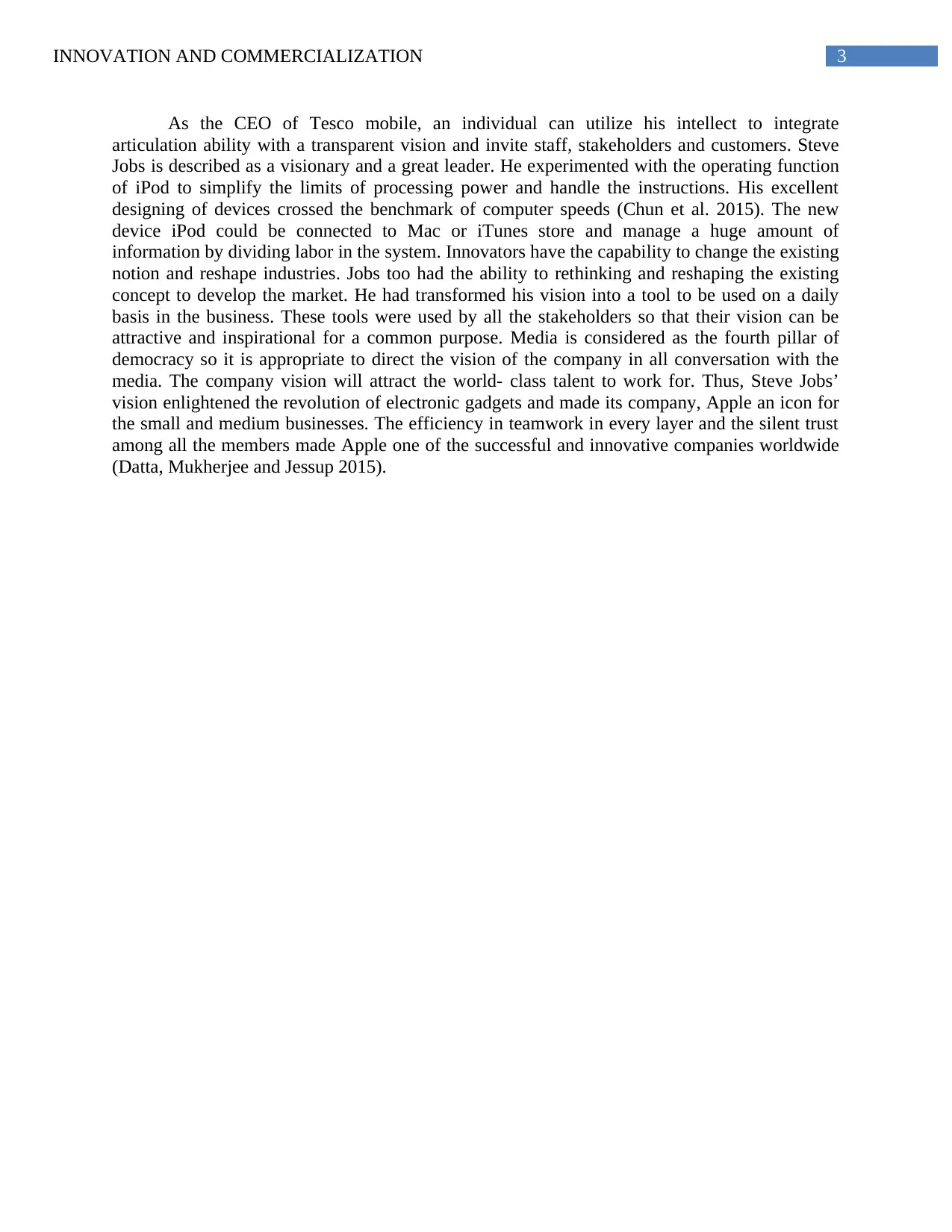
3INNOVATION AND COMMERCIALIZATION
As the CEO of Tesco mobile, an individual can utilize his intellect to integrate
articulation ability with a transparent vision and invite staff, stakeholders and customers. Steve
Jobs is described as a visionary and a great leader. He experimented with the operating function
of iPod to simplify the limits of processing power and handle the instructions. His excellent
designing of devices crossed the benchmark of computer speeds (Chun et al. 2015). The new
device iPod could be connected to Mac or iTunes store and manage a huge amount of
information by dividing labor in the system. Innovators have the capability to change the existing
notion and reshape industries. Jobs too had the ability to rethinking and reshaping the existing
concept to develop the market. He had transformed his vision into a tool to be used on a daily
basis in the business. These tools were used by all the stakeholders so that their vision can be
attractive and inspirational for a common purpose. Media is considered as the fourth pillar of
democracy so it is appropriate to direct the vision of the company in all conversation with the
media. The company vision will attract the world- class talent to work for. Thus, Steve Jobs’
vision enlightened the revolution of electronic gadgets and made its company, Apple an icon for
the small and medium businesses. The efficiency in teamwork in every layer and the silent trust
among all the members made Apple one of the successful and innovative companies worldwide
(Datta, Mukherjee and Jessup 2015).
As the CEO of Tesco mobile, an individual can utilize his intellect to integrate
articulation ability with a transparent vision and invite staff, stakeholders and customers. Steve
Jobs is described as a visionary and a great leader. He experimented with the operating function
of iPod to simplify the limits of processing power and handle the instructions. His excellent
designing of devices crossed the benchmark of computer speeds (Chun et al. 2015). The new
device iPod could be connected to Mac or iTunes store and manage a huge amount of
information by dividing labor in the system. Innovators have the capability to change the existing
notion and reshape industries. Jobs too had the ability to rethinking and reshaping the existing
concept to develop the market. He had transformed his vision into a tool to be used on a daily
basis in the business. These tools were used by all the stakeholders so that their vision can be
attractive and inspirational for a common purpose. Media is considered as the fourth pillar of
democracy so it is appropriate to direct the vision of the company in all conversation with the
media. The company vision will attract the world- class talent to work for. Thus, Steve Jobs’
vision enlightened the revolution of electronic gadgets and made its company, Apple an icon for
the small and medium businesses. The efficiency in teamwork in every layer and the silent trust
among all the members made Apple one of the successful and innovative companies worldwide
(Datta, Mukherjee and Jessup 2015).
Paraphrase This Document
Need a fresh take? Get an instant paraphrase of this document with our AI Paraphraser
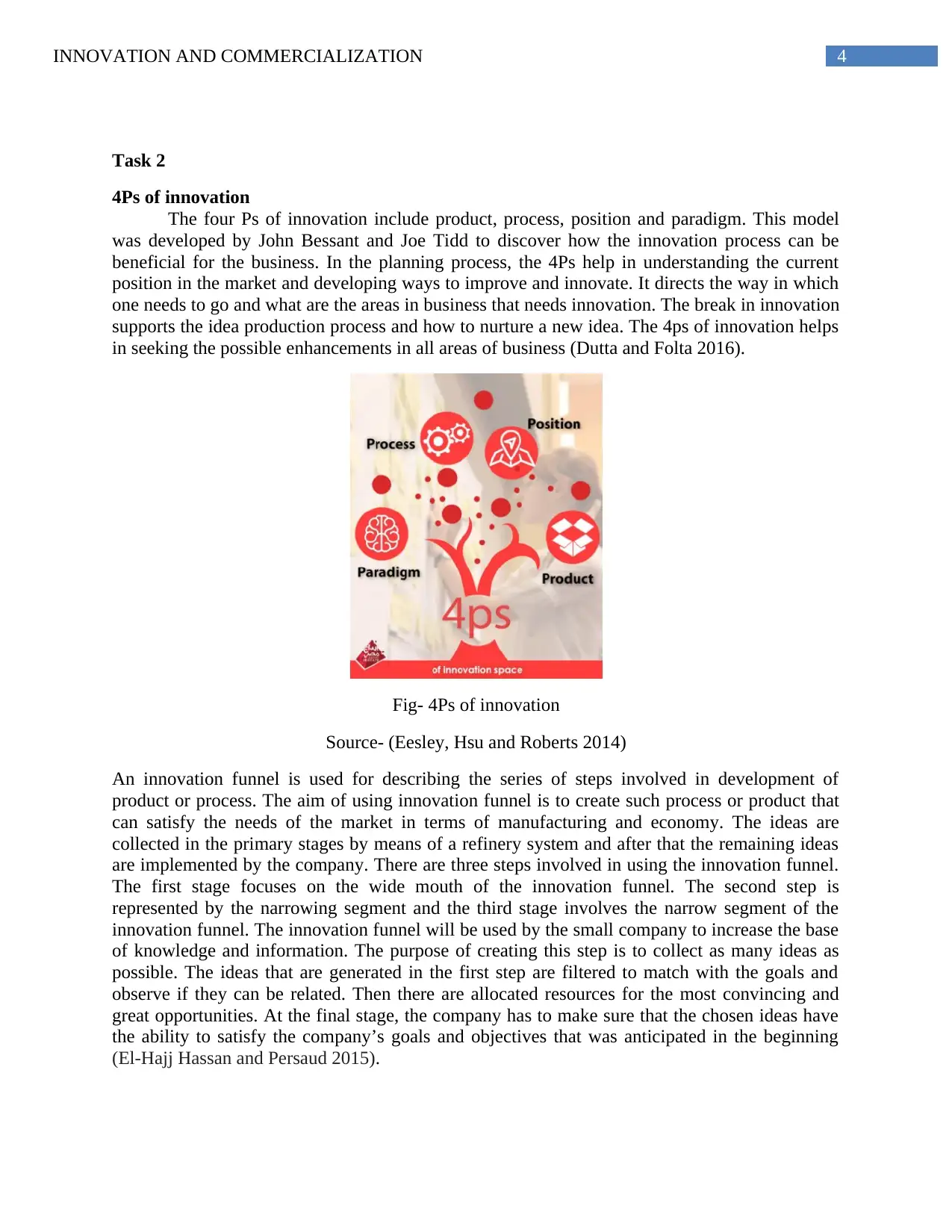
4INNOVATION AND COMMERCIALIZATION
Task 2
4Ps of innovation
The four Ps of innovation include product, process, position and paradigm. This model
was developed by John Bessant and Joe Tidd to discover how the innovation process can be
beneficial for the business. In the planning process, the 4Ps help in understanding the current
position in the market and developing ways to improve and innovate. It directs the way in which
one needs to go and what are the areas in business that needs innovation. The break in innovation
supports the idea production process and how to nurture a new idea. The 4ps of innovation helps
in seeking the possible enhancements in all areas of business (Dutta and Folta 2016).
Fig- 4Ps of innovation
Source- (Eesley, Hsu and Roberts 2014)
An innovation funnel is used for describing the series of steps involved in development of
product or process. The aim of using innovation funnel is to create such process or product that
can satisfy the needs of the market in terms of manufacturing and economy. The ideas are
collected in the primary stages by means of a refinery system and after that the remaining ideas
are implemented by the company. There are three steps involved in using the innovation funnel.
The first stage focuses on the wide mouth of the innovation funnel. The second step is
represented by the narrowing segment and the third stage involves the narrow segment of the
innovation funnel. The innovation funnel will be used by the small company to increase the base
of knowledge and information. The purpose of creating this step is to collect as many ideas as
possible. The ideas that are generated in the first step are filtered to match with the goals and
observe if they can be related. Then there are allocated resources for the most convincing and
great opportunities. At the final stage, the company has to make sure that the chosen ideas have
the ability to satisfy the company’s goals and objectives that was anticipated in the beginning
(El-Hajj Hassan and Persaud 2015).
Task 2
4Ps of innovation
The four Ps of innovation include product, process, position and paradigm. This model
was developed by John Bessant and Joe Tidd to discover how the innovation process can be
beneficial for the business. In the planning process, the 4Ps help in understanding the current
position in the market and developing ways to improve and innovate. It directs the way in which
one needs to go and what are the areas in business that needs innovation. The break in innovation
supports the idea production process and how to nurture a new idea. The 4ps of innovation helps
in seeking the possible enhancements in all areas of business (Dutta and Folta 2016).
Fig- 4Ps of innovation
Source- (Eesley, Hsu and Roberts 2014)
An innovation funnel is used for describing the series of steps involved in development of
product or process. The aim of using innovation funnel is to create such process or product that
can satisfy the needs of the market in terms of manufacturing and economy. The ideas are
collected in the primary stages by means of a refinery system and after that the remaining ideas
are implemented by the company. There are three steps involved in using the innovation funnel.
The first stage focuses on the wide mouth of the innovation funnel. The second step is
represented by the narrowing segment and the third stage involves the narrow segment of the
innovation funnel. The innovation funnel will be used by the small company to increase the base
of knowledge and information. The purpose of creating this step is to collect as many ideas as
possible. The ideas that are generated in the first step are filtered to match with the goals and
observe if they can be related. Then there are allocated resources for the most convincing and
great opportunities. At the final stage, the company has to make sure that the chosen ideas have
the ability to satisfy the company’s goals and objectives that was anticipated in the beginning
(El-Hajj Hassan and Persaud 2015).
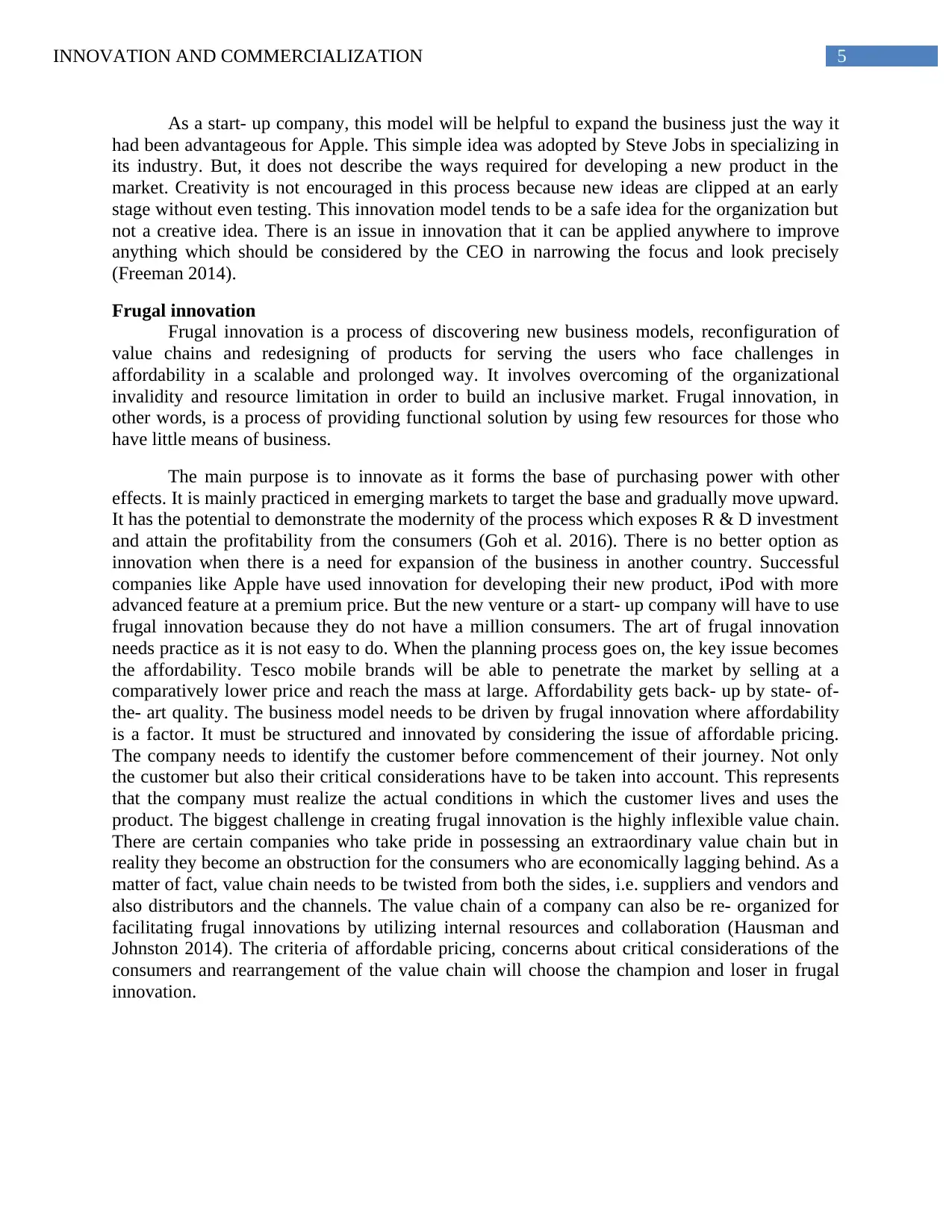
5INNOVATION AND COMMERCIALIZATION
As a start- up company, this model will be helpful to expand the business just the way it
had been advantageous for Apple. This simple idea was adopted by Steve Jobs in specializing in
its industry. But, it does not describe the ways required for developing a new product in the
market. Creativity is not encouraged in this process because new ideas are clipped at an early
stage without even testing. This innovation model tends to be a safe idea for the organization but
not a creative idea. There is an issue in innovation that it can be applied anywhere to improve
anything which should be considered by the CEO in narrowing the focus and look precisely
(Freeman 2014).
Frugal innovation
Frugal innovation is a process of discovering new business models, reconfiguration of
value chains and redesigning of products for serving the users who face challenges in
affordability in a scalable and prolonged way. It involves overcoming of the organizational
invalidity and resource limitation in order to build an inclusive market. Frugal innovation, in
other words, is a process of providing functional solution by using few resources for those who
have little means of business.
The main purpose is to innovate as it forms the base of purchasing power with other
effects. It is mainly practiced in emerging markets to target the base and gradually move upward.
It has the potential to demonstrate the modernity of the process which exposes R & D investment
and attain the profitability from the consumers (Goh et al. 2016). There is no better option as
innovation when there is a need for expansion of the business in another country. Successful
companies like Apple have used innovation for developing their new product, iPod with more
advanced feature at a premium price. But the new venture or a start- up company will have to use
frugal innovation because they do not have a million consumers. The art of frugal innovation
needs practice as it is not easy to do. When the planning process goes on, the key issue becomes
the affordability. Tesco mobile brands will be able to penetrate the market by selling at a
comparatively lower price and reach the mass at large. Affordability gets back- up by state- of-
the- art quality. The business model needs to be driven by frugal innovation where affordability
is a factor. It must be structured and innovated by considering the issue of affordable pricing.
The company needs to identify the customer before commencement of their journey. Not only
the customer but also their critical considerations have to be taken into account. This represents
that the company must realize the actual conditions in which the customer lives and uses the
product. The biggest challenge in creating frugal innovation is the highly inflexible value chain.
There are certain companies who take pride in possessing an extraordinary value chain but in
reality they become an obstruction for the consumers who are economically lagging behind. As a
matter of fact, value chain needs to be twisted from both the sides, i.e. suppliers and vendors and
also distributors and the channels. The value chain of a company can also be re- organized for
facilitating frugal innovations by utilizing internal resources and collaboration (Hausman and
Johnston 2014). The criteria of affordable pricing, concerns about critical considerations of the
consumers and rearrangement of the value chain will choose the champion and loser in frugal
innovation.
As a start- up company, this model will be helpful to expand the business just the way it
had been advantageous for Apple. This simple idea was adopted by Steve Jobs in specializing in
its industry. But, it does not describe the ways required for developing a new product in the
market. Creativity is not encouraged in this process because new ideas are clipped at an early
stage without even testing. This innovation model tends to be a safe idea for the organization but
not a creative idea. There is an issue in innovation that it can be applied anywhere to improve
anything which should be considered by the CEO in narrowing the focus and look precisely
(Freeman 2014).
Frugal innovation
Frugal innovation is a process of discovering new business models, reconfiguration of
value chains and redesigning of products for serving the users who face challenges in
affordability in a scalable and prolonged way. It involves overcoming of the organizational
invalidity and resource limitation in order to build an inclusive market. Frugal innovation, in
other words, is a process of providing functional solution by using few resources for those who
have little means of business.
The main purpose is to innovate as it forms the base of purchasing power with other
effects. It is mainly practiced in emerging markets to target the base and gradually move upward.
It has the potential to demonstrate the modernity of the process which exposes R & D investment
and attain the profitability from the consumers (Goh et al. 2016). There is no better option as
innovation when there is a need for expansion of the business in another country. Successful
companies like Apple have used innovation for developing their new product, iPod with more
advanced feature at a premium price. But the new venture or a start- up company will have to use
frugal innovation because they do not have a million consumers. The art of frugal innovation
needs practice as it is not easy to do. When the planning process goes on, the key issue becomes
the affordability. Tesco mobile brands will be able to penetrate the market by selling at a
comparatively lower price and reach the mass at large. Affordability gets back- up by state- of-
the- art quality. The business model needs to be driven by frugal innovation where affordability
is a factor. It must be structured and innovated by considering the issue of affordable pricing.
The company needs to identify the customer before commencement of their journey. Not only
the customer but also their critical considerations have to be taken into account. This represents
that the company must realize the actual conditions in which the customer lives and uses the
product. The biggest challenge in creating frugal innovation is the highly inflexible value chain.
There are certain companies who take pride in possessing an extraordinary value chain but in
reality they become an obstruction for the consumers who are economically lagging behind. As a
matter of fact, value chain needs to be twisted from both the sides, i.e. suppliers and vendors and
also distributors and the channels. The value chain of a company can also be re- organized for
facilitating frugal innovations by utilizing internal resources and collaboration (Hausman and
Johnston 2014). The criteria of affordable pricing, concerns about critical considerations of the
consumers and rearrangement of the value chain will choose the champion and loser in frugal
innovation.
⊘ This is a preview!⊘
Do you want full access?
Subscribe today to unlock all pages.

Trusted by 1+ million students worldwide
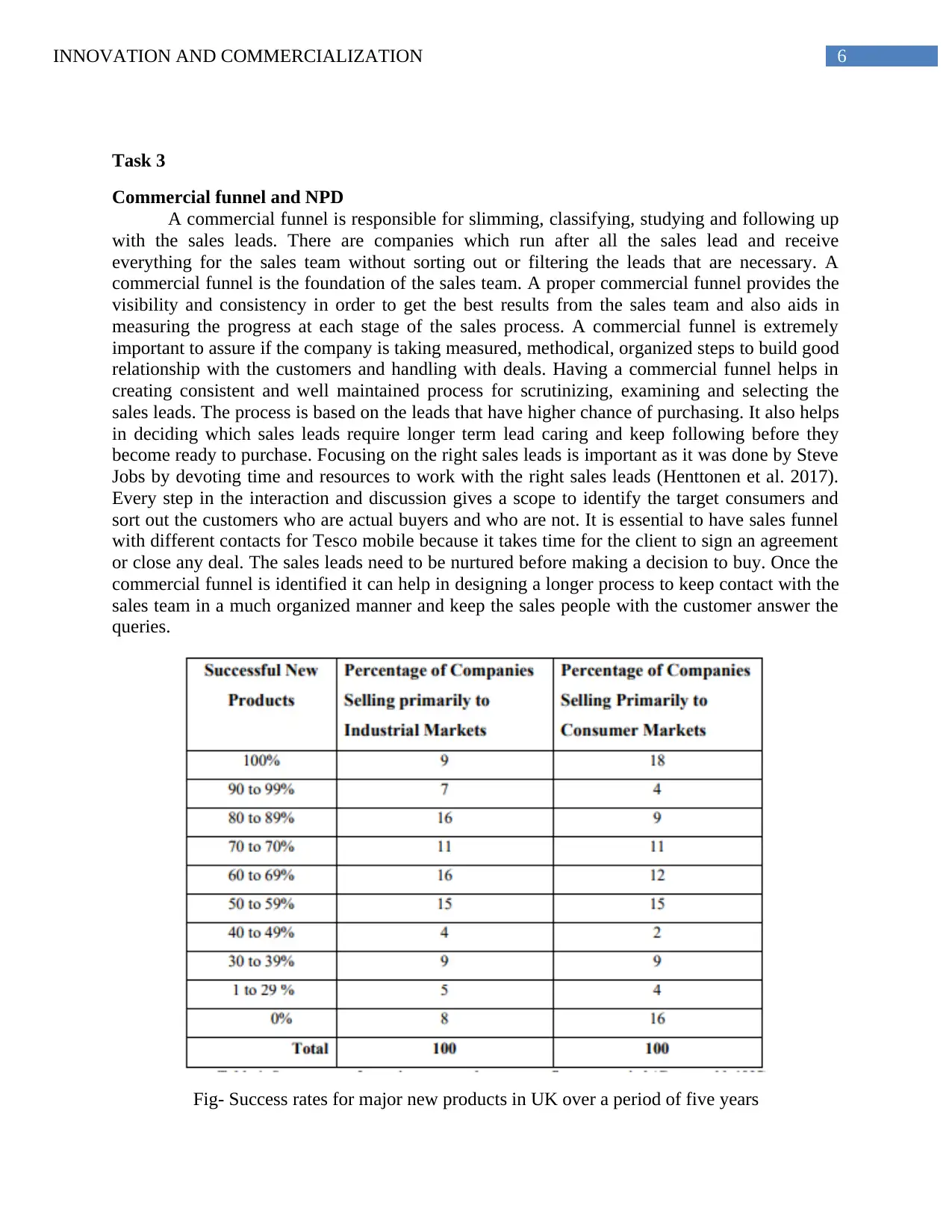
6INNOVATION AND COMMERCIALIZATION
Task 3
Commercial funnel and NPD
A commercial funnel is responsible for slimming, classifying, studying and following up
with the sales leads. There are companies which run after all the sales lead and receive
everything for the sales team without sorting out or filtering the leads that are necessary. A
commercial funnel is the foundation of the sales team. A proper commercial funnel provides the
visibility and consistency in order to get the best results from the sales team and also aids in
measuring the progress at each stage of the sales process. A commercial funnel is extremely
important to assure if the company is taking measured, methodical, organized steps to build good
relationship with the customers and handling with deals. Having a commercial funnel helps in
creating consistent and well maintained process for scrutinizing, examining and selecting the
sales leads. The process is based on the leads that have higher chance of purchasing. It also helps
in deciding which sales leads require longer term lead caring and keep following before they
become ready to purchase. Focusing on the right sales leads is important as it was done by Steve
Jobs by devoting time and resources to work with the right sales leads (Henttonen et al. 2017).
Every step in the interaction and discussion gives a scope to identify the target consumers and
sort out the customers who are actual buyers and who are not. It is essential to have sales funnel
with different contacts for Tesco mobile because it takes time for the client to sign an agreement
or close any deal. The sales leads need to be nurtured before making a decision to buy. Once the
commercial funnel is identified it can help in designing a longer process to keep contact with the
sales team in a much organized manner and keep the sales people with the customer answer the
queries.
Fig- Success rates for major new products in UK over a period of five years
Task 3
Commercial funnel and NPD
A commercial funnel is responsible for slimming, classifying, studying and following up
with the sales leads. There are companies which run after all the sales lead and receive
everything for the sales team without sorting out or filtering the leads that are necessary. A
commercial funnel is the foundation of the sales team. A proper commercial funnel provides the
visibility and consistency in order to get the best results from the sales team and also aids in
measuring the progress at each stage of the sales process. A commercial funnel is extremely
important to assure if the company is taking measured, methodical, organized steps to build good
relationship with the customers and handling with deals. Having a commercial funnel helps in
creating consistent and well maintained process for scrutinizing, examining and selecting the
sales leads. The process is based on the leads that have higher chance of purchasing. It also helps
in deciding which sales leads require longer term lead caring and keep following before they
become ready to purchase. Focusing on the right sales leads is important as it was done by Steve
Jobs by devoting time and resources to work with the right sales leads (Henttonen et al. 2017).
Every step in the interaction and discussion gives a scope to identify the target consumers and
sort out the customers who are actual buyers and who are not. It is essential to have sales funnel
with different contacts for Tesco mobile because it takes time for the client to sign an agreement
or close any deal. The sales leads need to be nurtured before making a decision to buy. Once the
commercial funnel is identified it can help in designing a longer process to keep contact with the
sales team in a much organized manner and keep the sales people with the customer answer the
queries.
Fig- Success rates for major new products in UK over a period of five years
Paraphrase This Document
Need a fresh take? Get an instant paraphrase of this document with our AI Paraphraser
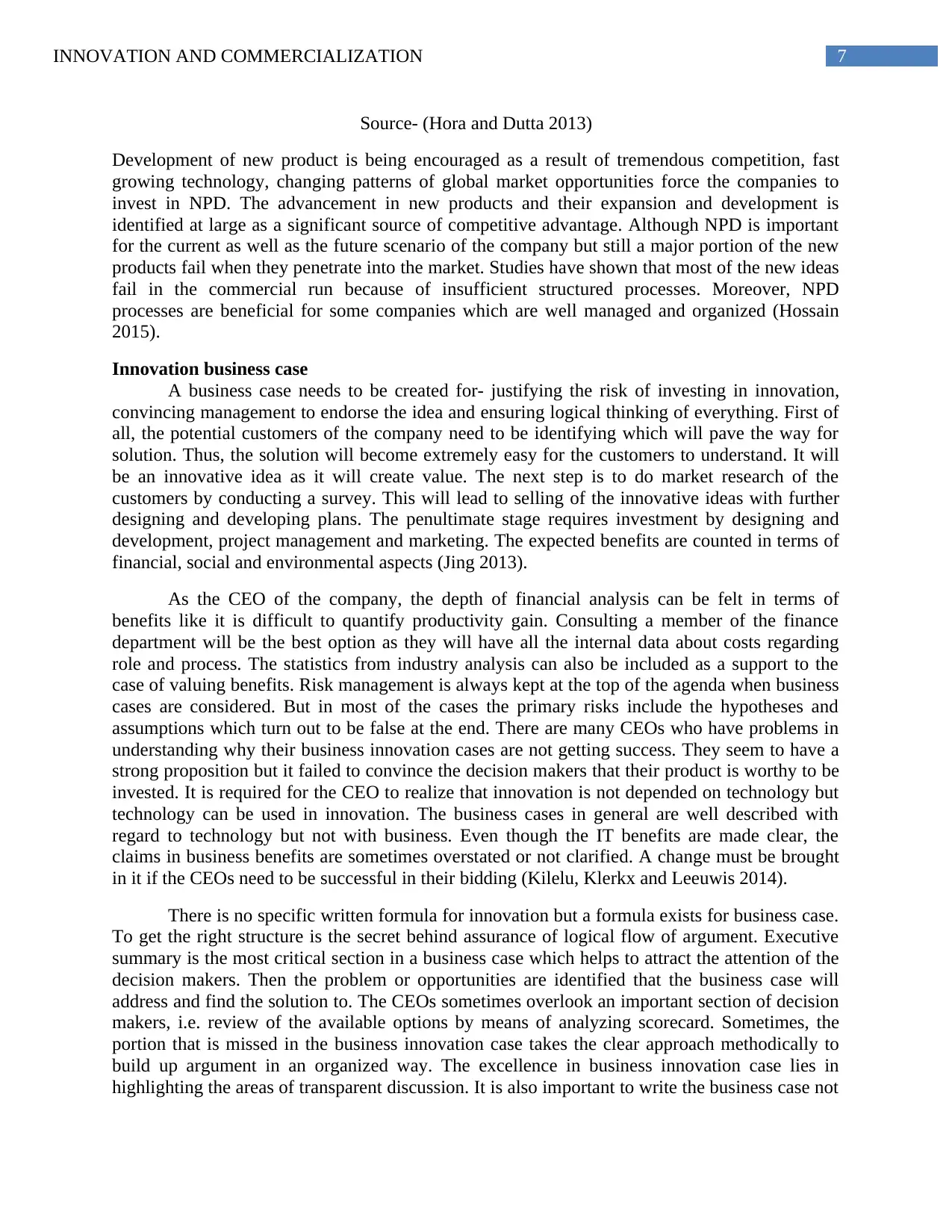
7INNOVATION AND COMMERCIALIZATION
Source- (Hora and Dutta 2013)
Development of new product is being encouraged as a result of tremendous competition, fast
growing technology, changing patterns of global market opportunities force the companies to
invest in NPD. The advancement in new products and their expansion and development is
identified at large as a significant source of competitive advantage. Although NPD is important
for the current as well as the future scenario of the company but still a major portion of the new
products fail when they penetrate into the market. Studies have shown that most of the new ideas
fail in the commercial run because of insufficient structured processes. Moreover, NPD
processes are beneficial for some companies which are well managed and organized (Hossain
2015).
Innovation business case
A business case needs to be created for- justifying the risk of investing in innovation,
convincing management to endorse the idea and ensuring logical thinking of everything. First of
all, the potential customers of the company need to be identifying which will pave the way for
solution. Thus, the solution will become extremely easy for the customers to understand. It will
be an innovative idea as it will create value. The next step is to do market research of the
customers by conducting a survey. This will lead to selling of the innovative ideas with further
designing and developing plans. The penultimate stage requires investment by designing and
development, project management and marketing. The expected benefits are counted in terms of
financial, social and environmental aspects (Jing 2013).
As the CEO of the company, the depth of financial analysis can be felt in terms of
benefits like it is difficult to quantify productivity gain. Consulting a member of the finance
department will be the best option as they will have all the internal data about costs regarding
role and process. The statistics from industry analysis can also be included as a support to the
case of valuing benefits. Risk management is always kept at the top of the agenda when business
cases are considered. But in most of the cases the primary risks include the hypotheses and
assumptions which turn out to be false at the end. There are many CEOs who have problems in
understanding why their business innovation cases are not getting success. They seem to have a
strong proposition but it failed to convince the decision makers that their product is worthy to be
invested. It is required for the CEO to realize that innovation is not depended on technology but
technology can be used in innovation. The business cases in general are well described with
regard to technology but not with business. Even though the IT benefits are made clear, the
claims in business benefits are sometimes overstated or not clarified. A change must be brought
in it if the CEOs need to be successful in their bidding (Kilelu, Klerkx and Leeuwis 2014).
There is no specific written formula for innovation but a formula exists for business case.
To get the right structure is the secret behind assurance of logical flow of argument. Executive
summary is the most critical section in a business case which helps to attract the attention of the
decision makers. Then the problem or opportunities are identified that the business case will
address and find the solution to. The CEOs sometimes overlook an important section of decision
makers, i.e. review of the available options by means of analyzing scorecard. Sometimes, the
portion that is missed in the business innovation case takes the clear approach methodically to
build up argument in an organized way. The excellence in business innovation case lies in
highlighting the areas of transparent discussion. It is also important to write the business case not
Source- (Hora and Dutta 2013)
Development of new product is being encouraged as a result of tremendous competition, fast
growing technology, changing patterns of global market opportunities force the companies to
invest in NPD. The advancement in new products and their expansion and development is
identified at large as a significant source of competitive advantage. Although NPD is important
for the current as well as the future scenario of the company but still a major portion of the new
products fail when they penetrate into the market. Studies have shown that most of the new ideas
fail in the commercial run because of insufficient structured processes. Moreover, NPD
processes are beneficial for some companies which are well managed and organized (Hossain
2015).
Innovation business case
A business case needs to be created for- justifying the risk of investing in innovation,
convincing management to endorse the idea and ensuring logical thinking of everything. First of
all, the potential customers of the company need to be identifying which will pave the way for
solution. Thus, the solution will become extremely easy for the customers to understand. It will
be an innovative idea as it will create value. The next step is to do market research of the
customers by conducting a survey. This will lead to selling of the innovative ideas with further
designing and developing plans. The penultimate stage requires investment by designing and
development, project management and marketing. The expected benefits are counted in terms of
financial, social and environmental aspects (Jing 2013).
As the CEO of the company, the depth of financial analysis can be felt in terms of
benefits like it is difficult to quantify productivity gain. Consulting a member of the finance
department will be the best option as they will have all the internal data about costs regarding
role and process. The statistics from industry analysis can also be included as a support to the
case of valuing benefits. Risk management is always kept at the top of the agenda when business
cases are considered. But in most of the cases the primary risks include the hypotheses and
assumptions which turn out to be false at the end. There are many CEOs who have problems in
understanding why their business innovation cases are not getting success. They seem to have a
strong proposition but it failed to convince the decision makers that their product is worthy to be
invested. It is required for the CEO to realize that innovation is not depended on technology but
technology can be used in innovation. The business cases in general are well described with
regard to technology but not with business. Even though the IT benefits are made clear, the
claims in business benefits are sometimes overstated or not clarified. A change must be brought
in it if the CEOs need to be successful in their bidding (Kilelu, Klerkx and Leeuwis 2014).
There is no specific written formula for innovation but a formula exists for business case.
To get the right structure is the secret behind assurance of logical flow of argument. Executive
summary is the most critical section in a business case which helps to attract the attention of the
decision makers. Then the problem or opportunities are identified that the business case will
address and find the solution to. The CEOs sometimes overlook an important section of decision
makers, i.e. review of the available options by means of analyzing scorecard. Sometimes, the
portion that is missed in the business innovation case takes the clear approach methodically to
build up argument in an organized way. The excellence in business innovation case lies in
highlighting the areas of transparent discussion. It is also important to write the business case not
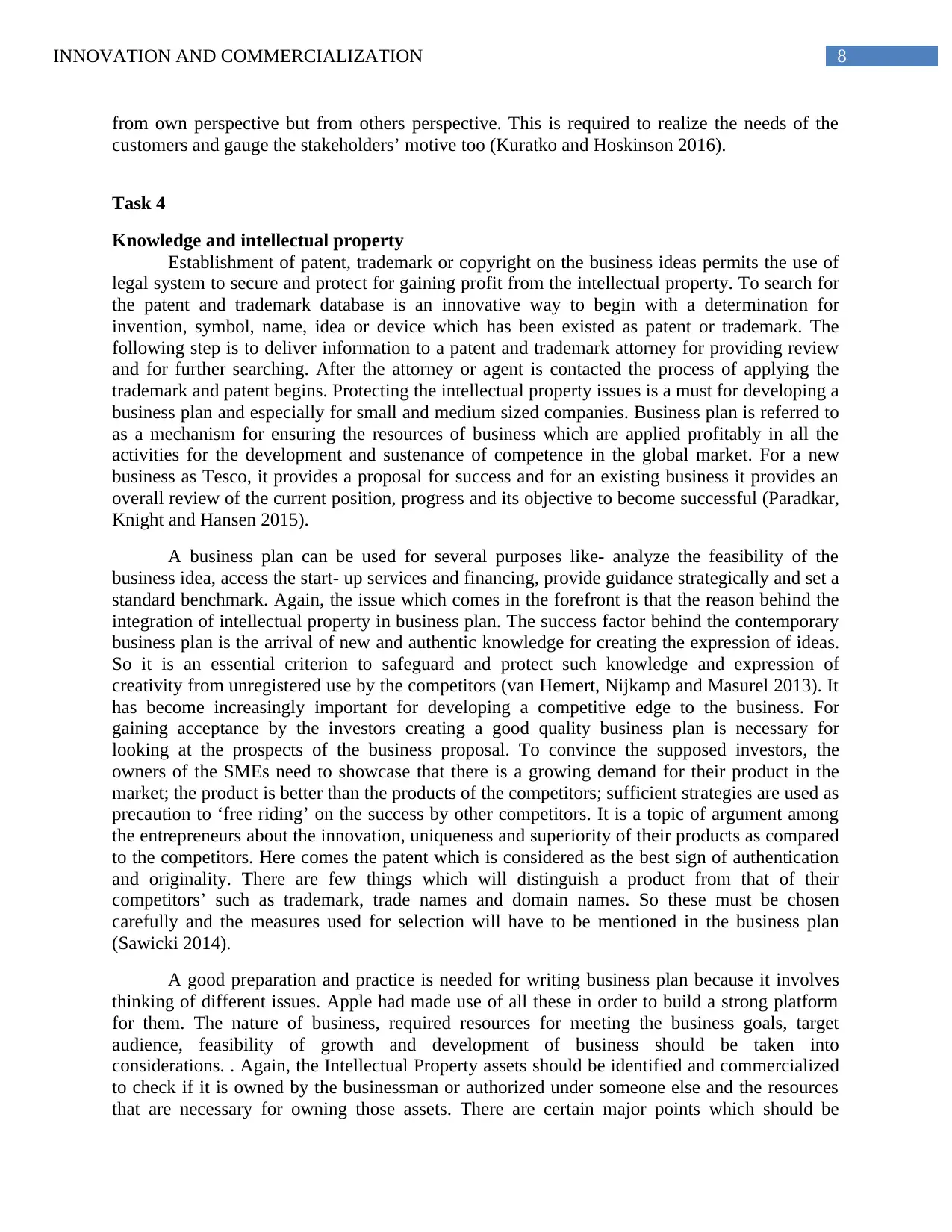
8INNOVATION AND COMMERCIALIZATION
from own perspective but from others perspective. This is required to realize the needs of the
customers and gauge the stakeholders’ motive too (Kuratko and Hoskinson 2016).
Task 4
Knowledge and intellectual property
Establishment of patent, trademark or copyright on the business ideas permits the use of
legal system to secure and protect for gaining profit from the intellectual property. To search for
the patent and trademark database is an innovative way to begin with a determination for
invention, symbol, name, idea or device which has been existed as patent or trademark. The
following step is to deliver information to a patent and trademark attorney for providing review
and for further searching. After the attorney or agent is contacted the process of applying the
trademark and patent begins. Protecting the intellectual property issues is a must for developing a
business plan and especially for small and medium sized companies. Business plan is referred to
as a mechanism for ensuring the resources of business which are applied profitably in all the
activities for the development and sustenance of competence in the global market. For a new
business as Tesco, it provides a proposal for success and for an existing business it provides an
overall review of the current position, progress and its objective to become successful (Paradkar,
Knight and Hansen 2015).
A business plan can be used for several purposes like- analyze the feasibility of the
business idea, access the start- up services and financing, provide guidance strategically and set a
standard benchmark. Again, the issue which comes in the forefront is that the reason behind the
integration of intellectual property in business plan. The success factor behind the contemporary
business plan is the arrival of new and authentic knowledge for creating the expression of ideas.
So it is an essential criterion to safeguard and protect such knowledge and expression of
creativity from unregistered use by the competitors (van Hemert, Nijkamp and Masurel 2013). It
has become increasingly important for developing a competitive edge to the business. For
gaining acceptance by the investors creating a good quality business plan is necessary for
looking at the prospects of the business proposal. To convince the supposed investors, the
owners of the SMEs need to showcase that there is a growing demand for their product in the
market; the product is better than the products of the competitors; sufficient strategies are used as
precaution to ‘free riding’ on the success by other competitors. It is a topic of argument among
the entrepreneurs about the innovation, uniqueness and superiority of their products as compared
to the competitors. Here comes the patent which is considered as the best sign of authentication
and originality. There are few things which will distinguish a product from that of their
competitors’ such as trademark, trade names and domain names. So these must be chosen
carefully and the measures used for selection will have to be mentioned in the business plan
(Sawicki 2014).
A good preparation and practice is needed for writing business plan because it involves
thinking of different issues. Apple had made use of all these in order to build a strong platform
for them. The nature of business, required resources for meeting the business goals, target
audience, feasibility of growth and development of business should be taken into
considerations. . Again, the Intellectual Property assets should be identified and commercialized
to check if it is owned by the businessman or authorized under someone else and the resources
that are necessary for owning those assets. There are certain major points which should be
from own perspective but from others perspective. This is required to realize the needs of the
customers and gauge the stakeholders’ motive too (Kuratko and Hoskinson 2016).
Task 4
Knowledge and intellectual property
Establishment of patent, trademark or copyright on the business ideas permits the use of
legal system to secure and protect for gaining profit from the intellectual property. To search for
the patent and trademark database is an innovative way to begin with a determination for
invention, symbol, name, idea or device which has been existed as patent or trademark. The
following step is to deliver information to a patent and trademark attorney for providing review
and for further searching. After the attorney or agent is contacted the process of applying the
trademark and patent begins. Protecting the intellectual property issues is a must for developing a
business plan and especially for small and medium sized companies. Business plan is referred to
as a mechanism for ensuring the resources of business which are applied profitably in all the
activities for the development and sustenance of competence in the global market. For a new
business as Tesco, it provides a proposal for success and for an existing business it provides an
overall review of the current position, progress and its objective to become successful (Paradkar,
Knight and Hansen 2015).
A business plan can be used for several purposes like- analyze the feasibility of the
business idea, access the start- up services and financing, provide guidance strategically and set a
standard benchmark. Again, the issue which comes in the forefront is that the reason behind the
integration of intellectual property in business plan. The success factor behind the contemporary
business plan is the arrival of new and authentic knowledge for creating the expression of ideas.
So it is an essential criterion to safeguard and protect such knowledge and expression of
creativity from unregistered use by the competitors (van Hemert, Nijkamp and Masurel 2013). It
has become increasingly important for developing a competitive edge to the business. For
gaining acceptance by the investors creating a good quality business plan is necessary for
looking at the prospects of the business proposal. To convince the supposed investors, the
owners of the SMEs need to showcase that there is a growing demand for their product in the
market; the product is better than the products of the competitors; sufficient strategies are used as
precaution to ‘free riding’ on the success by other competitors. It is a topic of argument among
the entrepreneurs about the innovation, uniqueness and superiority of their products as compared
to the competitors. Here comes the patent which is considered as the best sign of authentication
and originality. There are few things which will distinguish a product from that of their
competitors’ such as trademark, trade names and domain names. So these must be chosen
carefully and the measures used for selection will have to be mentioned in the business plan
(Sawicki 2014).
A good preparation and practice is needed for writing business plan because it involves
thinking of different issues. Apple had made use of all these in order to build a strong platform
for them. The nature of business, required resources for meeting the business goals, target
audience, feasibility of growth and development of business should be taken into
considerations. . Again, the Intellectual Property assets should be identified and commercialized
to check if it is owned by the businessman or authorized under someone else and the resources
that are necessary for owning those assets. There are certain major points which should be
⊘ This is a preview!⊘
Do you want full access?
Subscribe today to unlock all pages.

Trusted by 1+ million students worldwide
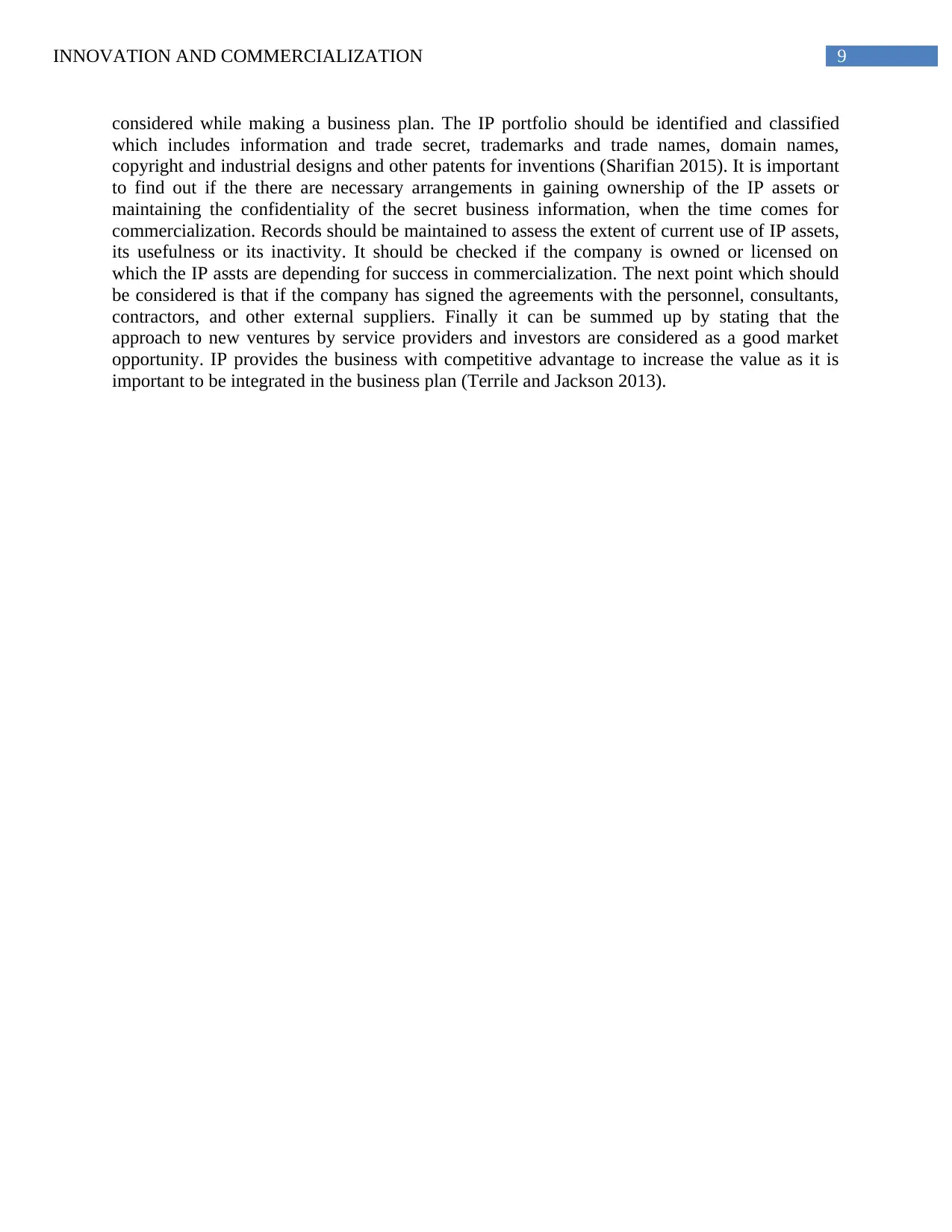
9INNOVATION AND COMMERCIALIZATION
considered while making a business plan. The IP portfolio should be identified and classified
which includes information and trade secret, trademarks and trade names, domain names,
copyright and industrial designs and other patents for inventions (Sharifian 2015). It is important
to find out if the there are necessary arrangements in gaining ownership of the IP assets or
maintaining the confidentiality of the secret business information, when the time comes for
commercialization. Records should be maintained to assess the extent of current use of IP assets,
its usefulness or its inactivity. It should be checked if the company is owned or licensed on
which the IP assts are depending for success in commercialization. The next point which should
be considered is that if the company has signed the agreements with the personnel, consultants,
contractors, and other external suppliers. Finally it can be summed up by stating that the
approach to new ventures by service providers and investors are considered as a good market
opportunity. IP provides the business with competitive advantage to increase the value as it is
important to be integrated in the business plan (Terrile and Jackson 2013).
considered while making a business plan. The IP portfolio should be identified and classified
which includes information and trade secret, trademarks and trade names, domain names,
copyright and industrial designs and other patents for inventions (Sharifian 2015). It is important
to find out if the there are necessary arrangements in gaining ownership of the IP assets or
maintaining the confidentiality of the secret business information, when the time comes for
commercialization. Records should be maintained to assess the extent of current use of IP assets,
its usefulness or its inactivity. It should be checked if the company is owned or licensed on
which the IP assts are depending for success in commercialization. The next point which should
be considered is that if the company has signed the agreements with the personnel, consultants,
contractors, and other external suppliers. Finally it can be summed up by stating that the
approach to new ventures by service providers and investors are considered as a good market
opportunity. IP provides the business with competitive advantage to increase the value as it is
important to be integrated in the business plan (Terrile and Jackson 2013).
Paraphrase This Document
Need a fresh take? Get an instant paraphrase of this document with our AI Paraphraser
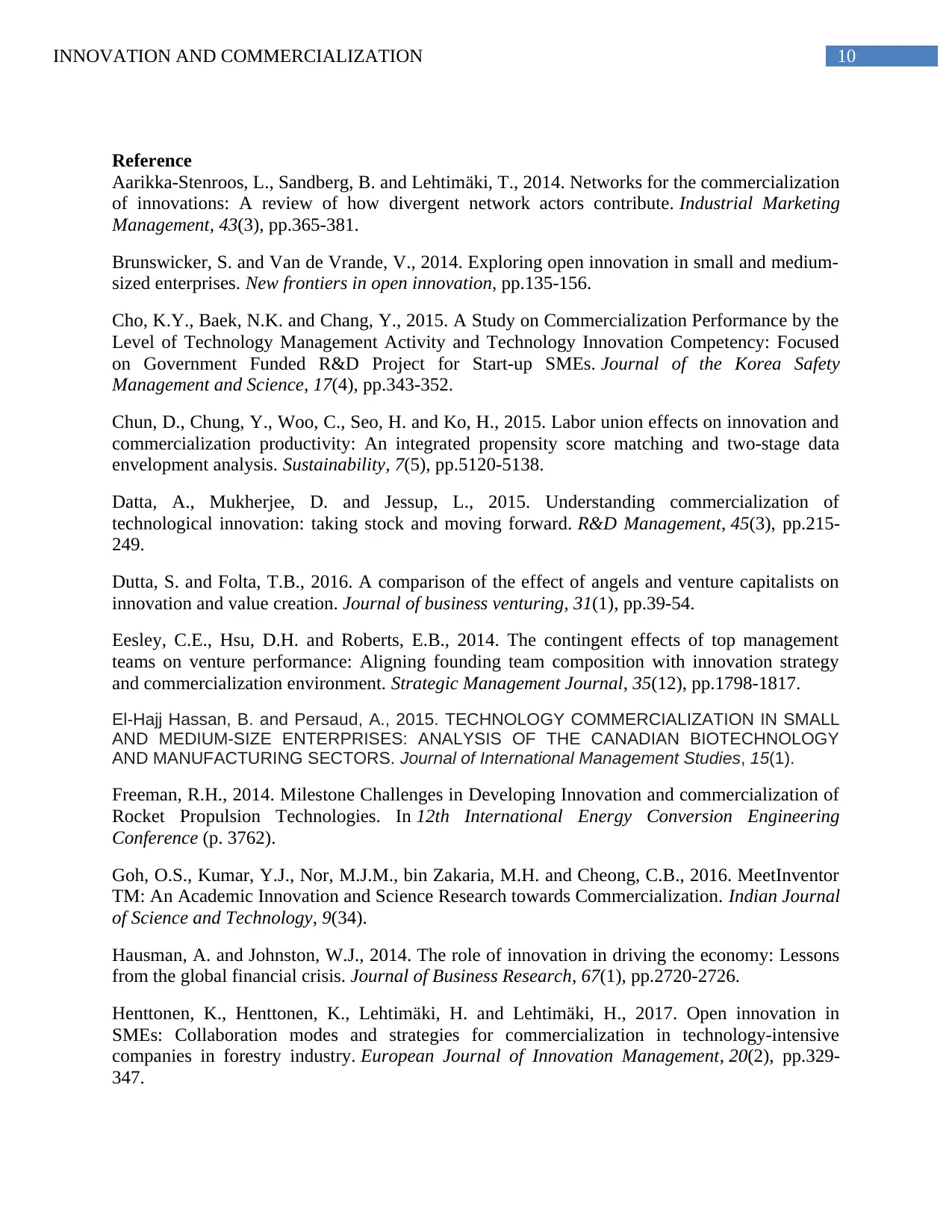
10INNOVATION AND COMMERCIALIZATION
Reference
Aarikka-Stenroos, L., Sandberg, B. and Lehtimäki, T., 2014. Networks for the commercialization
of innovations: A review of how divergent network actors contribute. Industrial Marketing
Management, 43(3), pp.365-381.
Brunswicker, S. and Van de Vrande, V., 2014. Exploring open innovation in small and medium-
sized enterprises. New frontiers in open innovation, pp.135-156.
Cho, K.Y., Baek, N.K. and Chang, Y., 2015. A Study on Commercialization Performance by the
Level of Technology Management Activity and Technology Innovation Competency: Focused
on Government Funded R&D Project for Start-up SMEs. Journal of the Korea Safety
Management and Science, 17(4), pp.343-352.
Chun, D., Chung, Y., Woo, C., Seo, H. and Ko, H., 2015. Labor union effects on innovation and
commercialization productivity: An integrated propensity score matching and two-stage data
envelopment analysis. Sustainability, 7(5), pp.5120-5138.
Datta, A., Mukherjee, D. and Jessup, L., 2015. Understanding commercialization of
technological innovation: taking stock and moving forward. R&D Management, 45(3), pp.215-
249.
Dutta, S. and Folta, T.B., 2016. A comparison of the effect of angels and venture capitalists on
innovation and value creation. Journal of business venturing, 31(1), pp.39-54.
Eesley, C.E., Hsu, D.H. and Roberts, E.B., 2014. The contingent effects of top management
teams on venture performance: Aligning founding team composition with innovation strategy
and commercialization environment. Strategic Management Journal, 35(12), pp.1798-1817.
El-Hajj Hassan, B. and Persaud, A., 2015. TECHNOLOGY COMMERCIALIZATION IN SMALL
AND MEDIUM-SIZE ENTERPRISES: ANALYSIS OF THE CANADIAN BIOTECHNOLOGY
AND MANUFACTURING SECTORS. Journal of International Management Studies, 15(1).
Freeman, R.H., 2014. Milestone Challenges in Developing Innovation and commercialization of
Rocket Propulsion Technologies. In 12th International Energy Conversion Engineering
Conference (p. 3762).
Goh, O.S., Kumar, Y.J., Nor, M.J.M., bin Zakaria, M.H. and Cheong, C.B., 2016. MeetInventor
TM: An Academic Innovation and Science Research towards Commercialization. Indian Journal
of Science and Technology, 9(34).
Hausman, A. and Johnston, W.J., 2014. The role of innovation in driving the economy: Lessons
from the global financial crisis. Journal of Business Research, 67(1), pp.2720-2726.
Henttonen, K., Henttonen, K., Lehtimäki, H. and Lehtimäki, H., 2017. Open innovation in
SMEs: Collaboration modes and strategies for commercialization in technology-intensive
companies in forestry industry. European Journal of Innovation Management, 20(2), pp.329-
347.
Reference
Aarikka-Stenroos, L., Sandberg, B. and Lehtimäki, T., 2014. Networks for the commercialization
of innovations: A review of how divergent network actors contribute. Industrial Marketing
Management, 43(3), pp.365-381.
Brunswicker, S. and Van de Vrande, V., 2014. Exploring open innovation in small and medium-
sized enterprises. New frontiers in open innovation, pp.135-156.
Cho, K.Y., Baek, N.K. and Chang, Y., 2015. A Study on Commercialization Performance by the
Level of Technology Management Activity and Technology Innovation Competency: Focused
on Government Funded R&D Project for Start-up SMEs. Journal of the Korea Safety
Management and Science, 17(4), pp.343-352.
Chun, D., Chung, Y., Woo, C., Seo, H. and Ko, H., 2015. Labor union effects on innovation and
commercialization productivity: An integrated propensity score matching and two-stage data
envelopment analysis. Sustainability, 7(5), pp.5120-5138.
Datta, A., Mukherjee, D. and Jessup, L., 2015. Understanding commercialization of
technological innovation: taking stock and moving forward. R&D Management, 45(3), pp.215-
249.
Dutta, S. and Folta, T.B., 2016. A comparison of the effect of angels and venture capitalists on
innovation and value creation. Journal of business venturing, 31(1), pp.39-54.
Eesley, C.E., Hsu, D.H. and Roberts, E.B., 2014. The contingent effects of top management
teams on venture performance: Aligning founding team composition with innovation strategy
and commercialization environment. Strategic Management Journal, 35(12), pp.1798-1817.
El-Hajj Hassan, B. and Persaud, A., 2015. TECHNOLOGY COMMERCIALIZATION IN SMALL
AND MEDIUM-SIZE ENTERPRISES: ANALYSIS OF THE CANADIAN BIOTECHNOLOGY
AND MANUFACTURING SECTORS. Journal of International Management Studies, 15(1).
Freeman, R.H., 2014. Milestone Challenges in Developing Innovation and commercialization of
Rocket Propulsion Technologies. In 12th International Energy Conversion Engineering
Conference (p. 3762).
Goh, O.S., Kumar, Y.J., Nor, M.J.M., bin Zakaria, M.H. and Cheong, C.B., 2016. MeetInventor
TM: An Academic Innovation and Science Research towards Commercialization. Indian Journal
of Science and Technology, 9(34).
Hausman, A. and Johnston, W.J., 2014. The role of innovation in driving the economy: Lessons
from the global financial crisis. Journal of Business Research, 67(1), pp.2720-2726.
Henttonen, K., Henttonen, K., Lehtimäki, H. and Lehtimäki, H., 2017. Open innovation in
SMEs: Collaboration modes and strategies for commercialization in technology-intensive
companies in forestry industry. European Journal of Innovation Management, 20(2), pp.329-
347.
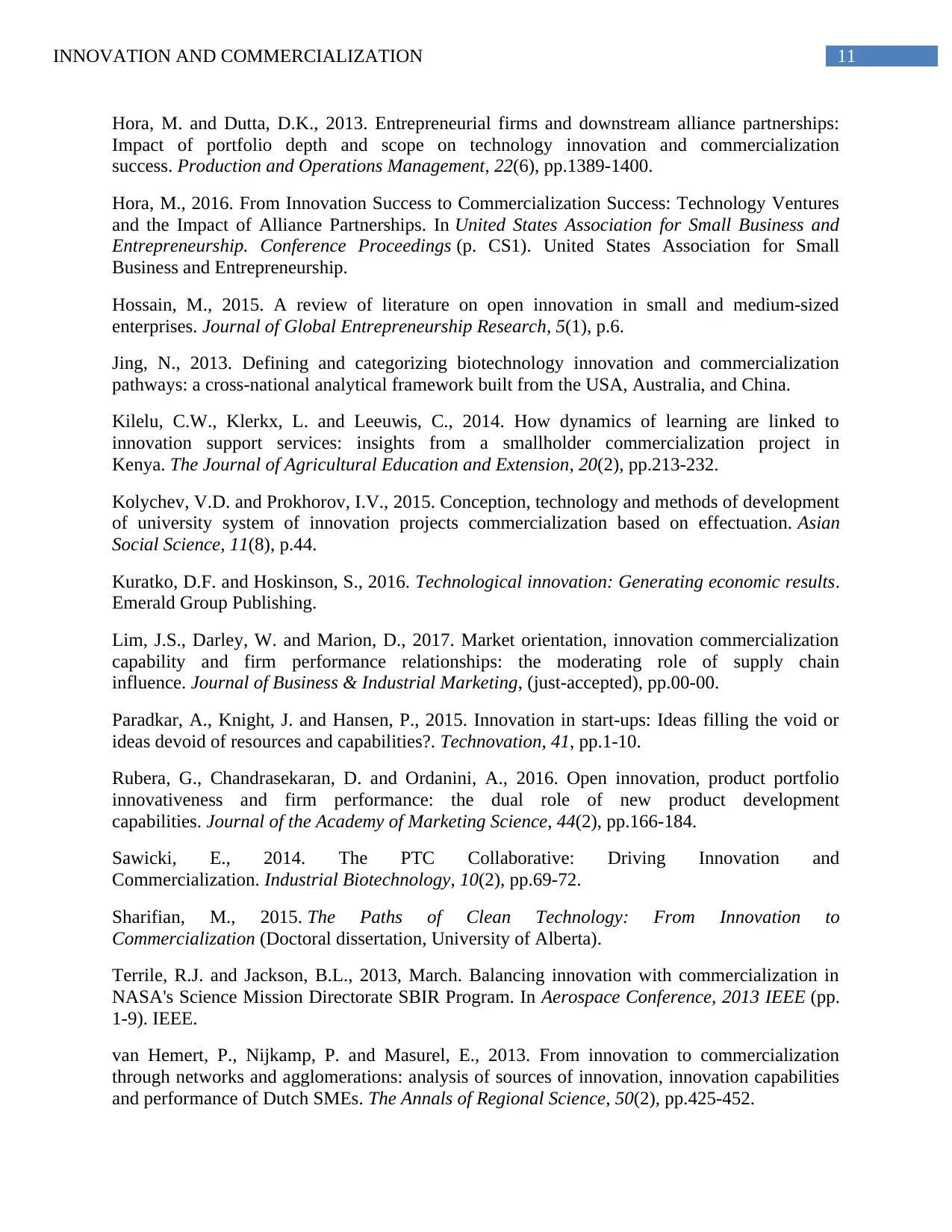
11INNOVATION AND COMMERCIALIZATION
Hora, M. and Dutta, D.K., 2013. Entrepreneurial firms and downstream alliance partnerships:
Impact of portfolio depth and scope on technology innovation and commercialization
success. Production and Operations Management, 22(6), pp.1389-1400.
Hora, M., 2016. From Innovation Success to Commercialization Success: Technology Ventures
and the Impact of Alliance Partnerships. In United States Association for Small Business and
Entrepreneurship. Conference Proceedings (p. CS1). United States Association for Small
Business and Entrepreneurship.
Hossain, M., 2015. A review of literature on open innovation in small and medium-sized
enterprises. Journal of Global Entrepreneurship Research, 5(1), p.6.
Jing, N., 2013. Defining and categorizing biotechnology innovation and commercialization
pathways: a cross-national analytical framework built from the USA, Australia, and China.
Kilelu, C.W., Klerkx, L. and Leeuwis, C., 2014. How dynamics of learning are linked to
innovation support services: insights from a smallholder commercialization project in
Kenya. The Journal of Agricultural Education and Extension, 20(2), pp.213-232.
Kolychev, V.D. and Prokhorov, I.V., 2015. Conception, technology and methods of development
of university system of innovation projects commercialization based on effectuation. Asian
Social Science, 11(8), p.44.
Kuratko, D.F. and Hoskinson, S., 2016. Technological innovation: Generating economic results.
Emerald Group Publishing.
Lim, J.S., Darley, W. and Marion, D., 2017. Market orientation, innovation commercialization
capability and firm performance relationships: the moderating role of supply chain
influence. Journal of Business & Industrial Marketing, (just-accepted), pp.00-00.
Paradkar, A., Knight, J. and Hansen, P., 2015. Innovation in start-ups: Ideas filling the void or
ideas devoid of resources and capabilities?. Technovation, 41, pp.1-10.
Rubera, G., Chandrasekaran, D. and Ordanini, A., 2016. Open innovation, product portfolio
innovativeness and firm performance: the dual role of new product development
capabilities. Journal of the Academy of Marketing Science, 44(2), pp.166-184.
Sawicki, E., 2014. The PTC Collaborative: Driving Innovation and
Commercialization. Industrial Biotechnology, 10(2), pp.69-72.
Sharifian, M., 2015. The Paths of Clean Technology: From Innovation to
Commercialization (Doctoral dissertation, University of Alberta).
Terrile, R.J. and Jackson, B.L., 2013, March. Balancing innovation with commercialization in
NASA's Science Mission Directorate SBIR Program. In Aerospace Conference, 2013 IEEE (pp.
1-9). IEEE.
van Hemert, P., Nijkamp, P. and Masurel, E., 2013. From innovation to commercialization
through networks and agglomerations: analysis of sources of innovation, innovation capabilities
and performance of Dutch SMEs. The Annals of Regional Science, 50(2), pp.425-452.
Hora, M. and Dutta, D.K., 2013. Entrepreneurial firms and downstream alliance partnerships:
Impact of portfolio depth and scope on technology innovation and commercialization
success. Production and Operations Management, 22(6), pp.1389-1400.
Hora, M., 2016. From Innovation Success to Commercialization Success: Technology Ventures
and the Impact of Alliance Partnerships. In United States Association for Small Business and
Entrepreneurship. Conference Proceedings (p. CS1). United States Association for Small
Business and Entrepreneurship.
Hossain, M., 2015. A review of literature on open innovation in small and medium-sized
enterprises. Journal of Global Entrepreneurship Research, 5(1), p.6.
Jing, N., 2013. Defining and categorizing biotechnology innovation and commercialization
pathways: a cross-national analytical framework built from the USA, Australia, and China.
Kilelu, C.W., Klerkx, L. and Leeuwis, C., 2014. How dynamics of learning are linked to
innovation support services: insights from a smallholder commercialization project in
Kenya. The Journal of Agricultural Education and Extension, 20(2), pp.213-232.
Kolychev, V.D. and Prokhorov, I.V., 2015. Conception, technology and methods of development
of university system of innovation projects commercialization based on effectuation. Asian
Social Science, 11(8), p.44.
Kuratko, D.F. and Hoskinson, S., 2016. Technological innovation: Generating economic results.
Emerald Group Publishing.
Lim, J.S., Darley, W. and Marion, D., 2017. Market orientation, innovation commercialization
capability and firm performance relationships: the moderating role of supply chain
influence. Journal of Business & Industrial Marketing, (just-accepted), pp.00-00.
Paradkar, A., Knight, J. and Hansen, P., 2015. Innovation in start-ups: Ideas filling the void or
ideas devoid of resources and capabilities?. Technovation, 41, pp.1-10.
Rubera, G., Chandrasekaran, D. and Ordanini, A., 2016. Open innovation, product portfolio
innovativeness and firm performance: the dual role of new product development
capabilities. Journal of the Academy of Marketing Science, 44(2), pp.166-184.
Sawicki, E., 2014. The PTC Collaborative: Driving Innovation and
Commercialization. Industrial Biotechnology, 10(2), pp.69-72.
Sharifian, M., 2015. The Paths of Clean Technology: From Innovation to
Commercialization (Doctoral dissertation, University of Alberta).
Terrile, R.J. and Jackson, B.L., 2013, March. Balancing innovation with commercialization in
NASA's Science Mission Directorate SBIR Program. In Aerospace Conference, 2013 IEEE (pp.
1-9). IEEE.
van Hemert, P., Nijkamp, P. and Masurel, E., 2013. From innovation to commercialization
through networks and agglomerations: analysis of sources of innovation, innovation capabilities
and performance of Dutch SMEs. The Annals of Regional Science, 50(2), pp.425-452.
⊘ This is a preview!⊘
Do you want full access?
Subscribe today to unlock all pages.

Trusted by 1+ million students worldwide
1 out of 13
Related Documents
Your All-in-One AI-Powered Toolkit for Academic Success.
+13062052269
info@desklib.com
Available 24*7 on WhatsApp / Email
![[object Object]](/_next/static/media/star-bottom.7253800d.svg)
Unlock your academic potential
Copyright © 2020–2025 A2Z Services. All Rights Reserved. Developed and managed by ZUCOL.





